Field Service Automation Guide: What It Is and How It Works
June 3, 2025 - 23 min read

June 3, 2025 - 23 min read

Table of Contents
| TL;DR: Field service automation streamlines operations with smart scheduling, real-time updates, and AI-driven workflows. It reduces costs, boosts technician efficiency, and improves customer satisfaction through faster, data-backed service. Tools like FieldCamp help automate field service workflows without complexity, making your operations scalable and future-ready. |
“Get closer than ever to your customers. So close that you tell them what they need well before they realize it.” — Steve Jobs
In field service operations, this means more than just fixing issues; it’s about anticipating needs, delivering fast and flawless service delivery, and managing customer relationships with precision.
Think of your field service business like a network of connected devices. Each technician, scheduler, and manager plays an important role, passing information seamlessly through the field service workflow.
This involves scheduling and dispatching technicians, tracking job status, and updating customer data in real time. Without the right software, this network can suffer from delays and errors that disrupt service.
Alex, a service manager at an HVAC company, faced these exact issues.
But after adopting a field service automation solution, he automated repetitive tasks, streamlined workflow automation, and equipped his field technicians with powerful mobile field service apps.
The result?
Faster service, improved customer satisfaction, and boosted employee productivity.
If you want your field teams to deliver consistent, high-quality service and exceed customer needs, understanding how field service automation works is the key.
Be the next Alex. Scroll down to learn how to become one, and share this with others, because the field service industry needs more leaders like him to drive evolution and raise the bar.
KEY HIGHLIGHTS
Inside the Shift Toward Smarter Field Operations
Field Service Automation (FSA) is the use of digital tools and software to streamline and manage field service operations. It automates key tasks like scheduling and dispatching technicians, tracking job status in real time, collecting customer data, and managing service history.
This reduces manual work, improves employee productivity, and ensures faster, more reliable service delivery.
With FSA, field service companies can maintain high standards of service quality while enhancing customer satisfaction and operational efficiency.
For years, field service businesses relied on spreadsheets, phone calls, and manual paperwork to manage field operations. This made tracking service calls, customer details, and technician performance slow and prone to errors.
But the game has changed.
Today, 70% of field service companies have invested in AI and ML Development Company, 59% in physical automation, and 54% in AR or wearable devices to streamline operations and empower technicians in the field.
The world is switching to intelligent, automated systems, and if you’re still stuck on spreadsheets, you’re falling behind.
These smart systems automate repetitive tasks like automated scheduling and dispatching technicians, enabling mobile workers to access job details on the go.
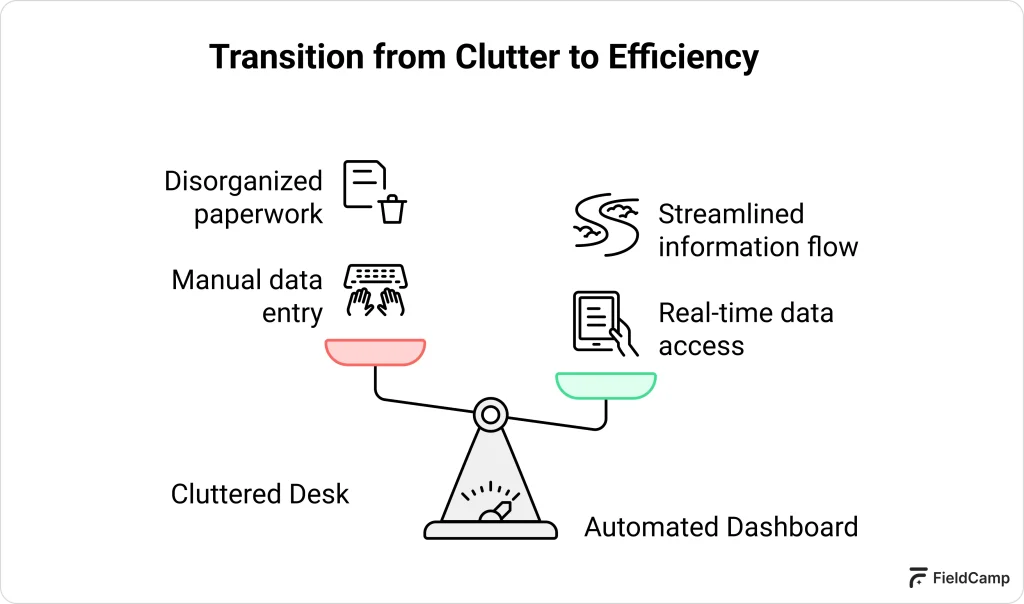
This shift not only saves time but also improves customer relationships by providing transparent updates and faster responses.
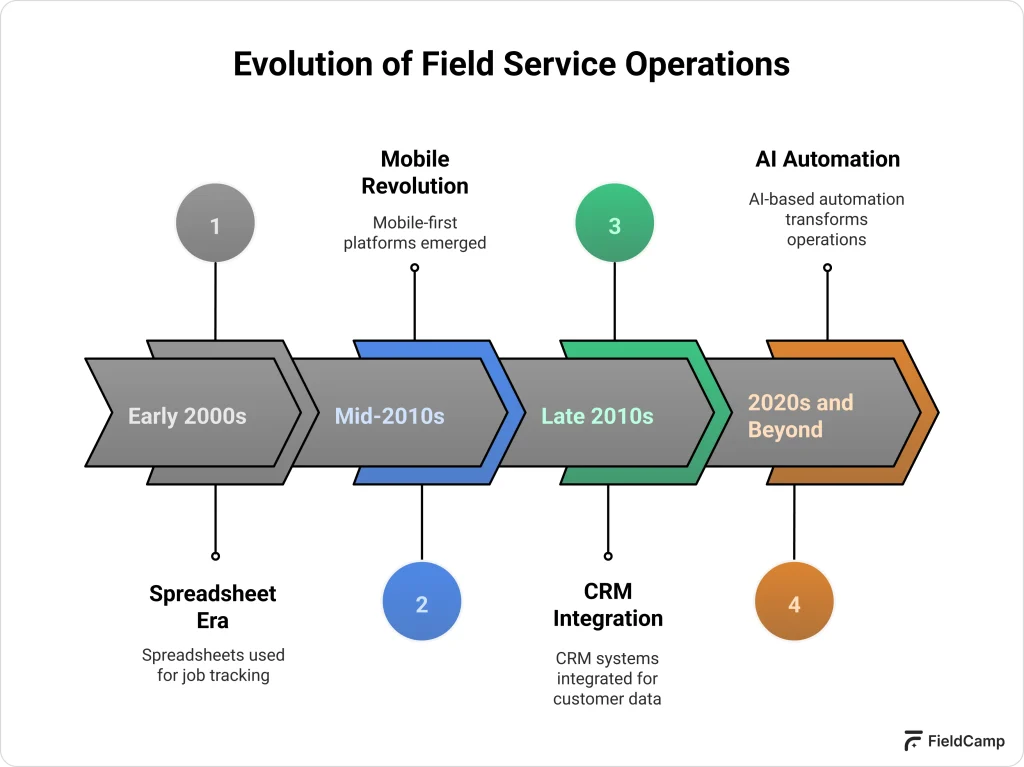
Just a few years ago, spreadsheets and sticky notes ran the show. But with mobility, real-time tools, and now AI, a smarter standard has taken over. Today’s service business isn’t just managed, it’s powered by systems that think and adapt.
That’s where FieldCamp filled the gap in between.
We’re not following the AI shift, we’re shaping it. As a next-gen field service management platform, FieldCamp transforms every manual task into an intelligent, automated flow.
From job scheduling to dispatch, customer relationship management, and efficient routing, our platform makes field operations frictionless.
Each feature isn’t just powered by AI, it’s designed to eliminate friction, reduce decision fatigue, and keep your field service software running smoothly without constant oversight.
Let AI Take the Wheel
FieldCamp makes field service ridiculously smart and hands-free.
The leap from manual to automated field service is more than just tech hype.
Studies show that companies using field service automation software reveal:
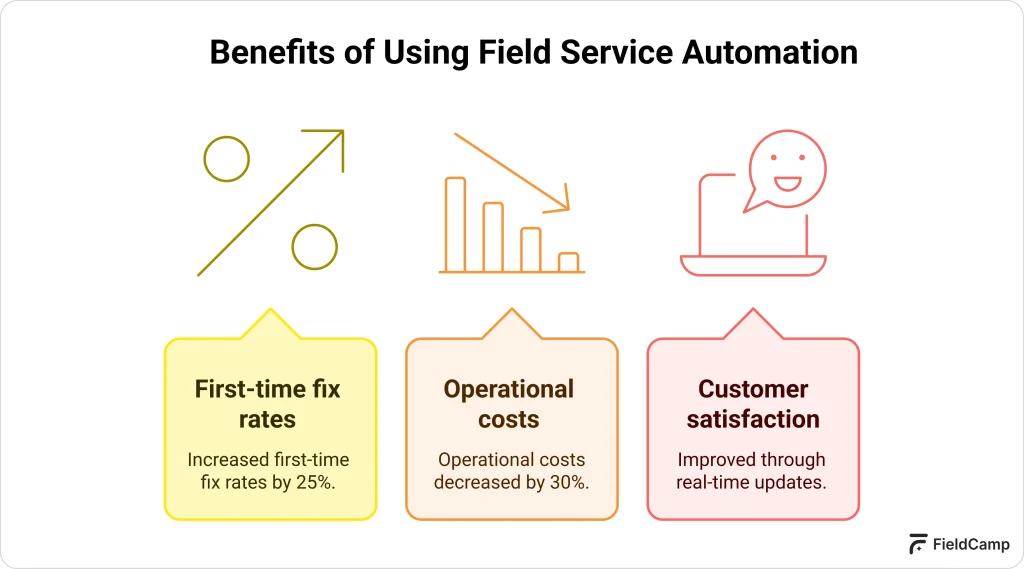
With smarter data collection and real-time communication, service managers can track technician performance and job status instantly, minimizing scheduling errors and boosting service quality.
Today’s customers don’t just want service, they expect fast, clear communication and seamless updates at every touchpoint. Alex knew great service wasn’t enough—73% of people value customer experience, yet only 49% feel companies deliver.
By automating routine tasks, he turned chaos into trackable excellence, cutting delays, boosting team visibility, and exceeding customer expectations at every touchpoint.
Now that we’ve seen why the shift to automation matters, let’s break down how it works.
Understanding how field service automation works means seeing the full picture, from the admin who plans and dispatches to the technician in the field delivering service.
Let’s explore both points of view step by step, revealing how automation streamlines every part of the field service workflow.
Efficient field service scheduling and dispatching powers smooth operations by automating technician assignment, calendar syncing, and route planning.
Alex’s POV: As the field service manager, I use automated scheduling to assign the right technician based on skills, availability, and location. This reduces manual errors and saves valuable time.
Technician’s POV: My schedule updates automatically on my mobile app. I know exactly where to be and when, with optimized routes cutting down my travel time.

Integrated inventory management tracks parts and tools, preventing delays and optimizing resource allocation.
Alex’s POV: The system monitors stock levels and alerts me when inventory is low, ensuring timely reordering.
Technician’s POV: I get notified about part availability so I can plan my workday without surprises.

Having instant access to job details and service history boosts first-time fix rates and service quality.
Alex’s POV: All service history and customer data are stored digitally and accessible by my team within seconds.
Technician’s POV: I retrieve job details and customer history on my mobile device before arriving on-site to prepare efficiently.

Live job tracking and status updates keep everyone informed, improving communication and customer satisfaction.
Alex’s POV: I monitor live job progress and technician locations to manage service calls proactively and update customers in real time.
Technician’s POV: My mobile app instantly updates job status, helping me report delays or completions without extra calls.

Field service automation enables mobile data collection and real-time on-site documentation, eliminating paperwork.
Alex’s POV: Technicians upload photos, collect digital signatures, and fill forms via mobile apps, streamlining workflows.
Technician’s POV: I document progress, capture evidence, and collect customer signatures directly from my device, speeding billing.
Use our labor cost calculator to calculate technician costs per job and align wages with service delivery goals.

Automated customer communication keeps clients updated and engaged, improving satisfaction and reducing no-shows.
Alex’s POV: I automate reminders and notifications to keep customers informed and reduce appointment cancellations.
Technician’s POV: Customers receive real-time updates on arrival times and job status, cutting down unnecessary calls.
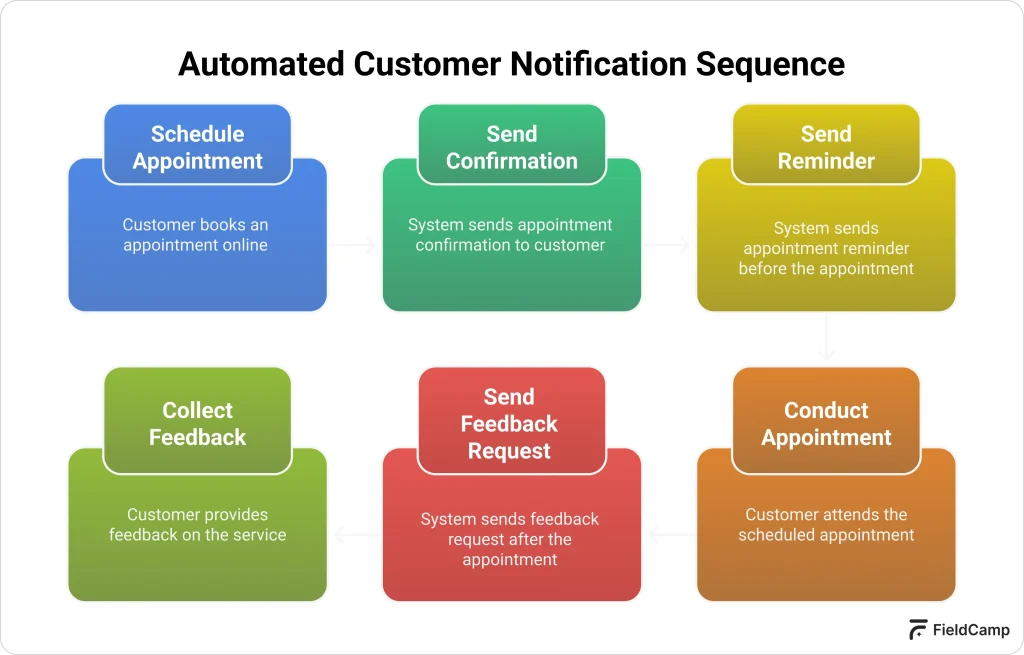
Automated reporting and performance analytics help optimize technician productivity and service quality.
Alex’s POV: Reports on KPIs and time logs identify trends and highlight areas for team coaching and improvement.
Technician’s POV: Access to my performance data helps me stay motivated and manage my workload efficiently.
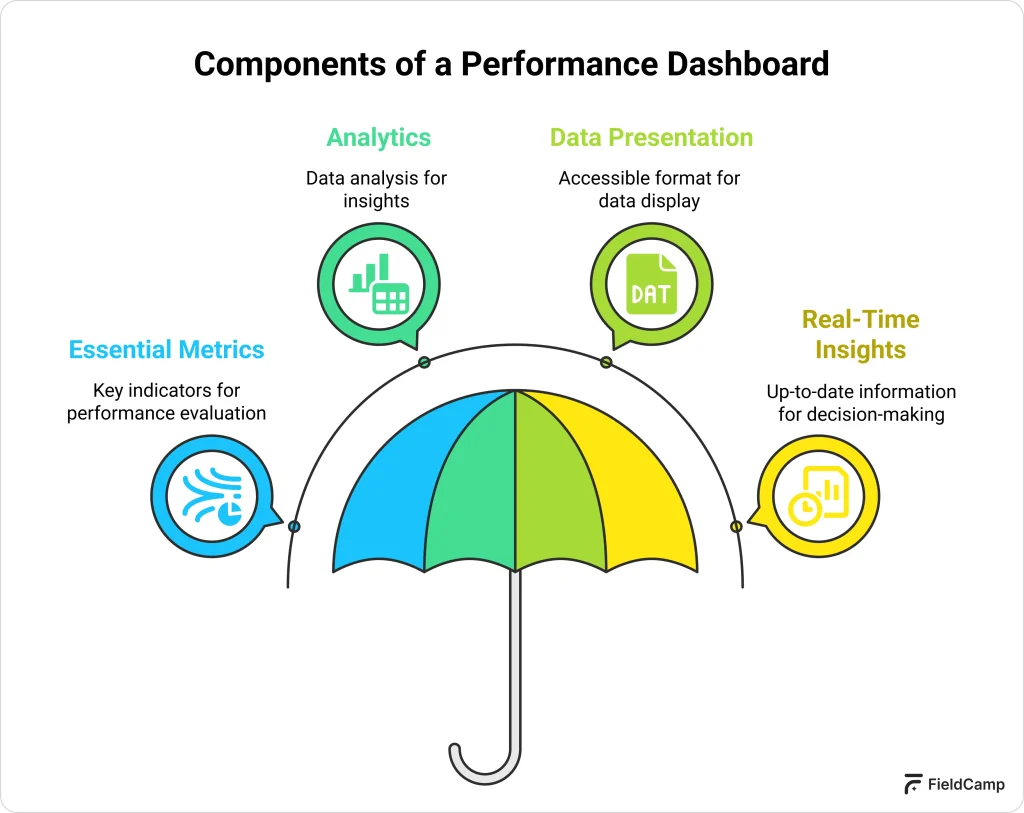
AI-driven workflow automation refines processes by learning from data, enhancing service quality, and operational efficiency.
Alex’s POV: Machine learning improves scheduling accuracy and route planning, driving smarter field service management.
Technician’s POV: Automation reduces routine tasks, letting me focus on delivering excellent customer service.
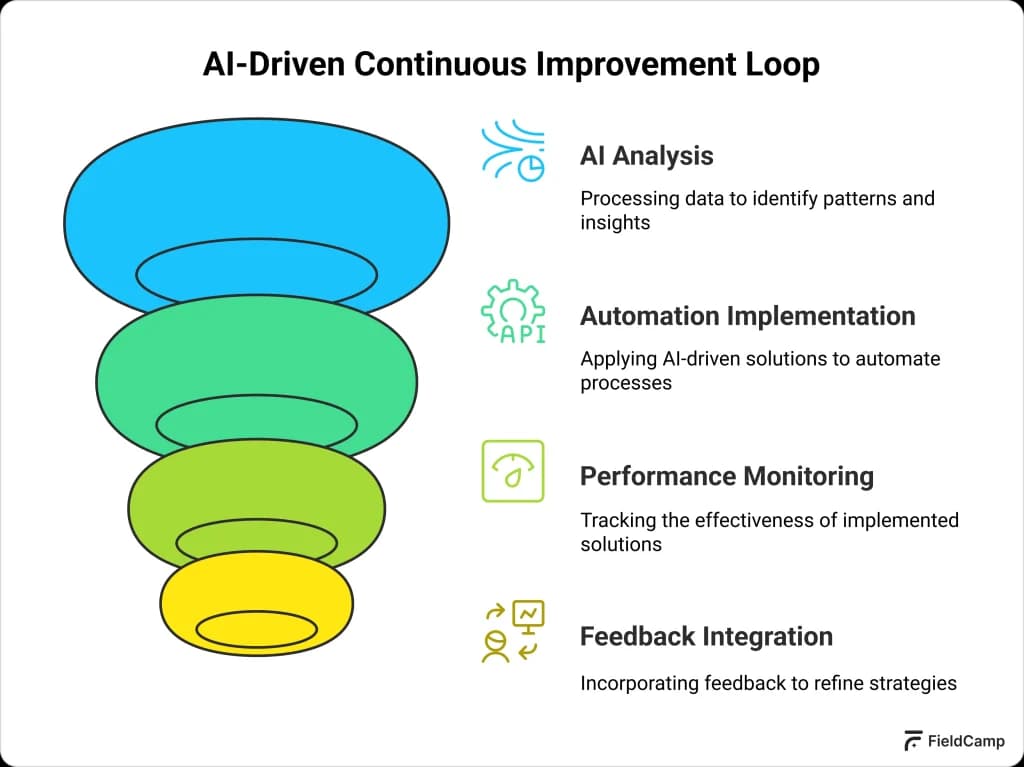
Choosing the right field service automation solution depends on how well it aligns with your operational and customer needs. Here are the key factors to consider:
| Criteria | Description |
| Pricing model | Understand whether the software charges per user, offers a flat rate, or uses a tiered pricing model based on features and usage. |
| Core features | Look for essentials like scheduling, mobile access, real-time updates, CRM integration, maintenance tools, and inventory management. |
| Industries served | Ensure the tool is aligned with your industry HVAC, plumbing, electrical, telecom, etc., as each has unique field service needs. |
| Unique benefits | Look for standout features like AI-based route optimization, offline access, customizable job forms, and system integrations. |
| Scalability & flexibility | The tool should support growth from small teams to large field ops without compromising speed, usability, or customization. |
| Customer communication & visibility | Tools with live technician tracking, automatic notifications, and real-time updates can significantly improve customer experience and transparency. |
The right platform should help field service organizations manage resources better, reduce operational costs, improve key performance indicators, and deliver higher customer satisfaction.
Want help building a scalable pricing structure for your field service business? Our service pricing guide walks you through the exact steps to price smarter while staying competitive.
Discover the best field service automation tools of 2025, built to streamline operations, cut costs, and empower field teams. Each tool below is reviewed for real-world performance, smart features, and seamless system integration.
FieldCamp stands out as one of the most reliable and easy-to-use Field Service Automation Software Solutions, purpose-built for businesses that want to digitize field operations, reduce manual work, and boost technician efficiency.

Key features:
1. Mobile-first interface
Designed for field service workers who are always on the move. Technicians can access job details, customer information, and route updates directly from their smartphones, minimizing errors and delays.
2. Live scheduling and dispatch board
Easily assign jobs, adjust technician availability, and view routes in real time. This enables smoother dispatching and helps teams respond faster to changing conditions, crucial for improving key performance indicators like job completion time and first-time fix rates.
3. Real-time data sync
Ensure every job status, customer update, and technician movement is instantly reflected across devices. This leads to seamless communication between office staff and field crews.
4. Smart route optimization
AI-powered routing automatically suggests the most efficient travel paths. This reduces technician travel time and operational costs while improving customer satisfaction through timely service.
5. Integration-ready
FieldCamp integrates smoothly with your existing systems, allowing for unified customer management, invoice generation, and calendar sync.
6. Custom job forms and smart checklists
Create and assign designed job forms and checklists that technicians can complete directly from the field. This helps manage documentation digitally, ensures task consistency, and supports preventive maintenance routines, making compliance and audits easier to handle.
In the rush to deliver features, onboarding often gets treated like a checkbox. But in reality, it’s the foundation of success.
At FieldCamp, we believe understanding field service automation begins with understanding your business, your workflows, your team, and your goals.
That’s why we don’t just hand you a login. We speak directly with your team to map out your job processes, configure tools to match your needs, and ensure every technician gets what they need from day one.
It’s a personalised approach designed to promote seamless communication and smooth adoption for all field service workers.
And if you’re wondering how important this is, just look at the community discussions on field service automation, like this Reddit thread where users debate whether a beginner can even get a system off the ground without expert help.
That’s exactly the gap we prefer to close. Don’t believe us? Try booking a demo and find out for yourself!
We stay with you through setup, offer personalized training, and provide ongoing support with full documentation, walkthroughs, and an on-demand video library. It’s not just onboarding, it’s a partnership that reduces confusion, accelerates usage, and ultimately lowers operational costs.
Suitable for:
FieldCamp is designed for field service organizations that value efficiency, ease of use, and adaptability. It supports the entire lifecycle of field service automation from scheduling and dispatch to customer management and preventive maintenance.
It’s a great fit for industries such as:
If your goal is to improve technician accountability, reduce missed appointments, and ensure seamless communication between office and field, FieldCamp delivers the structure and simplicity to make it happen.
A robust field service platform tightly integrated with the Salesforce CRM ecosystem.

Key features:
Our take: It’s powerful and flexible, especially for enterprises already using Salesforce. However, implementation can be time-consuming, and the learning curve is steep for smaller teams. It is best suited for large operations with in-house IT support.
Designed for mobile-first teams handling complex, on-the-fly scheduling.

Key features:
Our take: Skedulo works well for businesses with highly dynamic schedules. Some users note the UI could feel bulky, but it’s effective if your work involves high mobility and frequent job changes.
All-in-one software that connects field ops with phone and billing systems.

Key features:
Our take: It’s a good fit for service businesses that want everything in one place, especially phone features. Some reporting limitations exist, and the interface could use modernization, but it covers the basics reliably.
Curious how it stacks up in real-world use? Explore our full review here: fieldcamp.ai/reviews/service-fusion/
A straightforward tool for small service businesses looking to digitize operations.

Key features:
Our take: Jobber is beginner-friendly and built with small teams in mind. It doesn’t offer deep customization or advanced routing, but it helps service pros go paperless and stay organized.
Thinking about Jobber for your team? Our in-depth breakdown covers what to expect: fieldcamp.ai/reviews/jobber
Investing in the right field service automation software can transform your operations—but only if it fits your actual business needs. Before committing to a platform, ask the right questions to ensure it improves, not complicates your workflow.
Is it mobile-first?
Field service workers are always on the move. A mobile-friendly platform ensures they can access job info, checklists, and updates anytime, boosting operational efficiency in the field.
Does it integrate with your existing systems (CRM, Accounting)?
Seamless integration with tools you already use, like invoicing, payroll, or customer management, saves time, reduces errors, and ensures data flows without disruption.
Does it support offline access for remote areas?
The Internet isn’t always reliable in the field. Offline capability ensures jobs continue even when connectivity drops, and all data collected syncs when back online.
Is it scalable with your team growth?
You may start with 3 techs, but what about when you reach a headcount of 30? The solution should scale as your team expands, helping you manage resources without performance loss.
Can it adapt to your workflows and processes involved?
Every business is different. Make sure the tool aligns with how your jobs are scheduled, dispatched, and completed, not the other way around.
Not sure which tool to pick? We’ve made it easy. Use this 5-point checklist to compare top field service automation (FSA) tools side-by-side.
Make your decision in minutes:
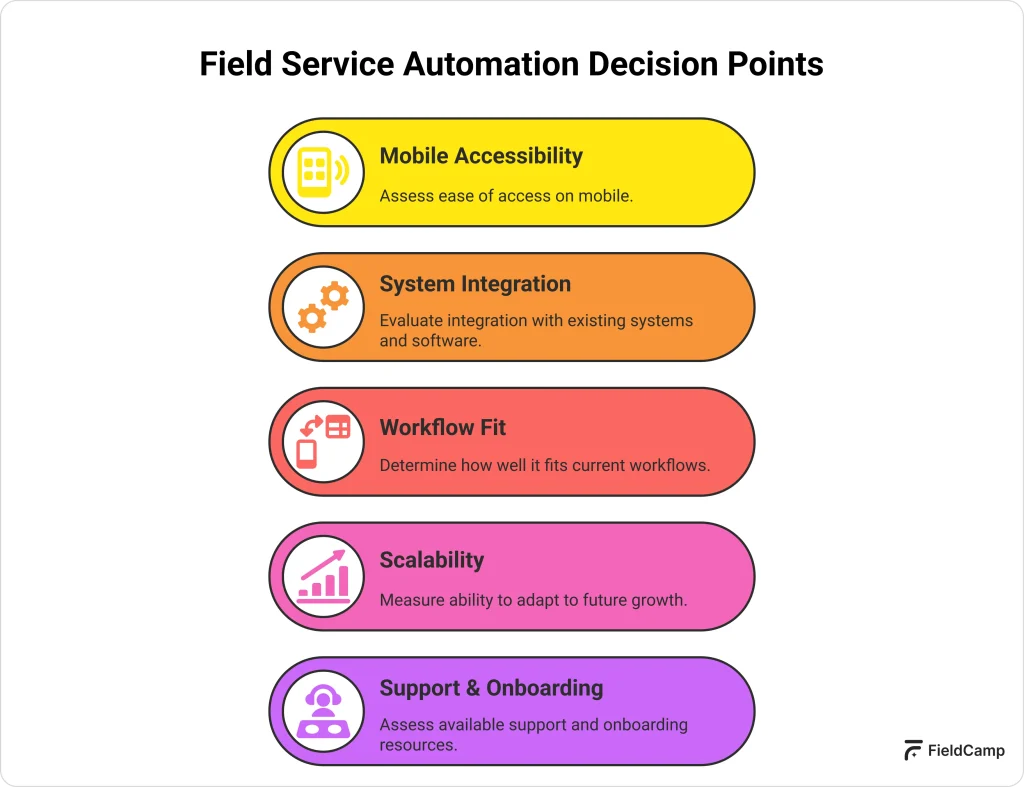
As technology evolves, so does field services automation, and we’re already seeing AI reshape how field teams operate.
From decision-making to technician routing, AI is becoming a core part of every field service automation platform.
The future of automated field service is even more promising:
As field automation software matures, businesses will increasingly ask: What field service automation tools move the needle?
The answer lies in choosing solutions that don’t just digitize but truly automate field service management and enable long-term growth through smart, adaptable systems.
So, if you’re exploring field service automation solutions today, think beyond features, look at how they’ll evolve with you tomorrow.
The rise of AI, mobile technology, and real-time data has made field service automation solutions more accessible, flexible, and impactful than ever before. Businesses no longer need to choose between efficiency and complexity, you can have both.
Whether you’re dealing with missed appointments, scattered job data, or sluggish communication, now is the time to rethink how you operate.
The right field service automation platform can streamline your team’s efforts, optimize travel time, and ensure consistent service delivery through complete field service business process automation.
If you’ve been wondering how to automate field services or improve task scheduling, documentation, or technician accountability, start with your workflows.
Once your workflows are optimized, use our service price calculator to ensure every job is priced for sustainable growth.
Fix Your Field Chaos
Stop babysitting your ops. Let FieldCamp automate what’s slowing you down.
AI improves field service workflow process automation by making smarter, real-time decisions for dispatching, routing, and job assignment. With AI-driven insights, teams can automate field service workflows based on technician skills, job urgency, and location, reducing errors and boosting efficiency. It’s the driving force behind predictive maintenance, intelligent scheduling, and faster response times in automated field service operations.
By using field automation software, companies can provide accurate arrival windows, real-time updates, and quicker resolutions, all of which lead to higher customer trust. Automated job tracking and digital documentation reduce delays, eliminate repeat visits, and ensure customers stay informed. Ultimately, automating field service management translates to faster service, better communication, and more consistent experiences.
Core components include scheduling tools, mobile apps, real-time data sync, customer records, digital job forms, and automated checklists. A robust field service automation platform also includes route optimization, inventory tracking, and seamless integration with your existing systems, all working together to enable field service business process automation.
Tools with built-in route optimization use real-time traffic, job priority, and technician proximity to plan the most efficient schedules. This reduces unnecessary mileage, improves fuel efficiency, and ensures smarter technician deployment. Over time, it leads to lower operational costs and faster service windows core benefits of how to automate field services effectively.